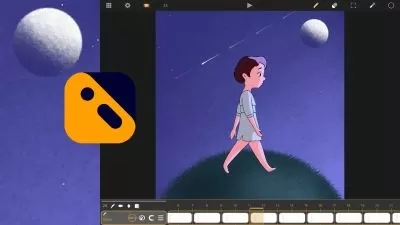CUDA Parallel Programming on NVIDIA GPUs (HW and SW)
13:16:49
Description
Performance Optimization and Analysis for High-Performance Computing
What You'll Learn?
- Comprehensive Understanding of GPU vs CPU Architecture
- learn the history of graphical processing unit (GPU) until the most recent products
- Understand the internal structure of GPU
- Understand the different types of memories and how they affect the performance
- Understand the most recent technologies in the GPU internal components
- Understand the basics of the CUDA programming on GPU
- Start programming GPU using both CUDA on Both windows and linux
- understand the most efficient ways for parallelization
- Profiling and Performance Tuning
- Leveraging Shared Memory
Who is this for?
What You Need to Know?
More details
DescriptionThis comprehensive course is designed for anyone looking to dive deep into CUDA programming and NVIDIA GPU architectures. Starting from the basics of GPU hardware, the course walks you through the evolution of NVIDIA's architectures, their key performance features, and the computational power of CUDA. With practical programming examples and step-by-step instruction, students will develop an in-depth understanding of GPU computing, CUDA programming, and performance optimization. Whether you're an experienced developer or new to parallel computing, this course provides the knowledge and skills necessary to harness the full potential of GPU programming.
Here's a refined summary of what you will gain from this CUDA programming course:
Comprehensive Understanding of GPU vs CPU Architecture: Students will learn the fundamental differences between GPUs and CPUs, gaining insight into how GPUs are designed for parallel processing tasks.
Deep Dive into NVIDIA's GPU Architectures: The course covers the evolution of NVIDIA's GPU architectures, including Fermi, Pascal, Volta, Ampere, and Hopper, and teaches how to compare different generations based on key performance parameters.
Hands-On CUDA Installation: Students will learn how to install CUDA across various operating systems, including Windows, Linux, and using WSL, while exploring the essential features that come with the CUDA toolkit.
Introduction to CUDA Programming Concepts: Through practical examples, students will understand core CUDA programming principles, including thread and block management, and how to develop parallel applications like vector addition.
Profiling and Performance Tuning: The course will guide students through using NVIDIA’s powerful profiling tools like Nsight Compute and nvprof to measure GPU performance and optimize code by addressing issues like occupancy and latency hiding.
Mastering 2D Indexing for Matrix Operations: Students will explore 2D indexing techniques for efficient matrix computations, learning to optimize memory access patterns and enhance performance.
Performance Optimization Techniques: They will acquire skills to optimize GPU programs through real-world examples, including handling non-power-of-2 data sizes and fine-tuning operations for maximum efficiency.
Leveraging Shared Memory: The course dives into how shared memory can boost CUDA application performance by improving data locality and minimizing global memory accesses.
Understanding Warp Divergence: Students will learn about warp divergence and its impact on performance, along with strategies to minimize it and ensure smooth execution of parallel threads.
Real-World Application of Profiling and Debugging: The course emphasizes practical use cases, where students will apply debugging techniques, error-checking APIs, and advanced profiling methods to fine-tune their CUDA programs for real-world applications.
By the end of the course, students will be proficient in CUDA programming, profiling, and optimization, equipping them with the skills to develop high-performance GPU applications.
Who this course is for:
- For any one interested in GPU and CUDA like engineering students, researchers and any other one
This comprehensive course is designed for anyone looking to dive deep into CUDA programming and NVIDIA GPU architectures. Starting from the basics of GPU hardware, the course walks you through the evolution of NVIDIA's architectures, their key performance features, and the computational power of CUDA. With practical programming examples and step-by-step instruction, students will develop an in-depth understanding of GPU computing, CUDA programming, and performance optimization. Whether you're an experienced developer or new to parallel computing, this course provides the knowledge and skills necessary to harness the full potential of GPU programming.
Here's a refined summary of what you will gain from this CUDA programming course:
Comprehensive Understanding of GPU vs CPU Architecture: Students will learn the fundamental differences between GPUs and CPUs, gaining insight into how GPUs are designed for parallel processing tasks.
Deep Dive into NVIDIA's GPU Architectures: The course covers the evolution of NVIDIA's GPU architectures, including Fermi, Pascal, Volta, Ampere, and Hopper, and teaches how to compare different generations based on key performance parameters.
Hands-On CUDA Installation: Students will learn how to install CUDA across various operating systems, including Windows, Linux, and using WSL, while exploring the essential features that come with the CUDA toolkit.
Introduction to CUDA Programming Concepts: Through practical examples, students will understand core CUDA programming principles, including thread and block management, and how to develop parallel applications like vector addition.
Profiling and Performance Tuning: The course will guide students through using NVIDIA’s powerful profiling tools like Nsight Compute and nvprof to measure GPU performance and optimize code by addressing issues like occupancy and latency hiding.
Mastering 2D Indexing for Matrix Operations: Students will explore 2D indexing techniques for efficient matrix computations, learning to optimize memory access patterns and enhance performance.
Performance Optimization Techniques: They will acquire skills to optimize GPU programs through real-world examples, including handling non-power-of-2 data sizes and fine-tuning operations for maximum efficiency.
Leveraging Shared Memory: The course dives into how shared memory can boost CUDA application performance by improving data locality and minimizing global memory accesses.
Understanding Warp Divergence: Students will learn about warp divergence and its impact on performance, along with strategies to minimize it and ensure smooth execution of parallel threads.
Real-World Application of Profiling and Debugging: The course emphasizes practical use cases, where students will apply debugging techniques, error-checking APIs, and advanced profiling methods to fine-tune their CUDA programs for real-world applications.
By the end of the course, students will be proficient in CUDA programming, profiling, and optimization, equipping them with the skills to develop high-performance GPU applications.
Who this course is for:
- For any one interested in GPU and CUDA like engineering students, researchers and any other one
User Reviews
Rating

Udemy
View courses Udemy- language english
- Training sessions 40
- duration 13:16:49
- Release Date 2025/03/09










